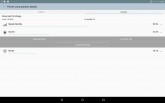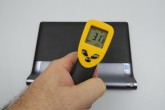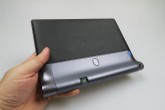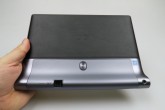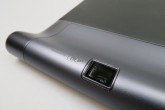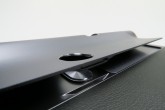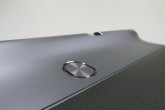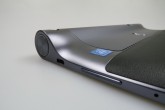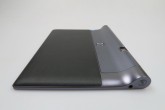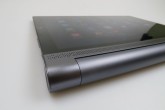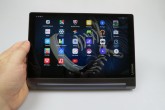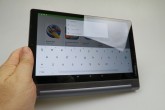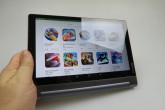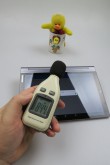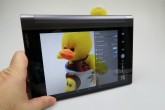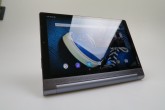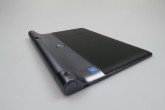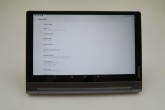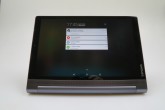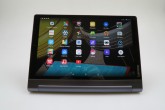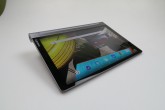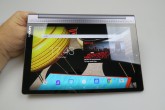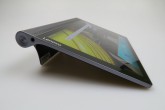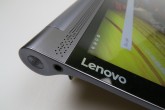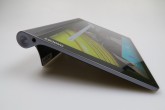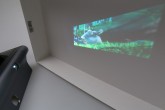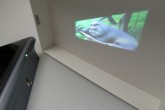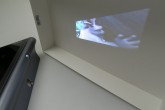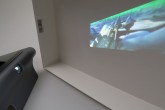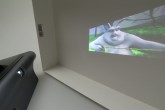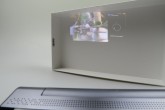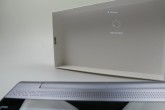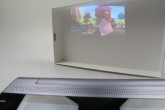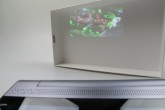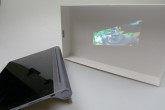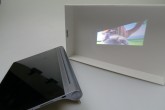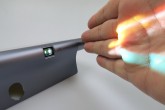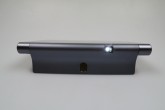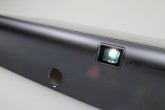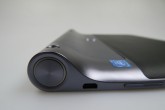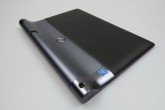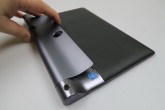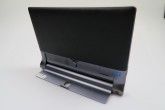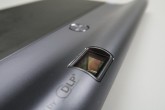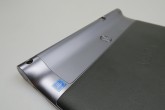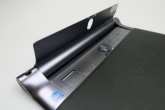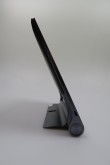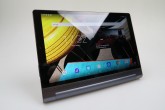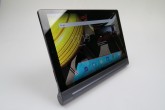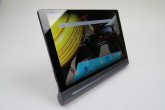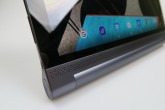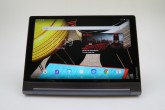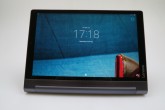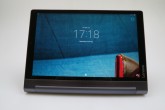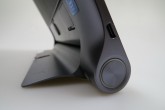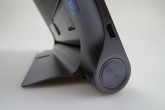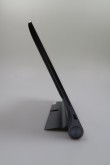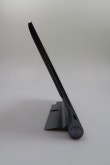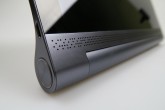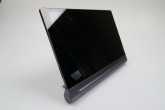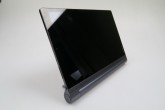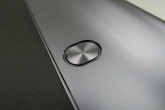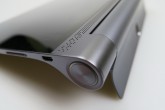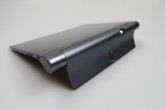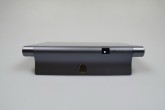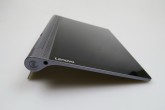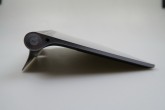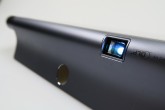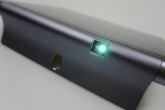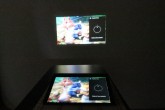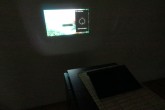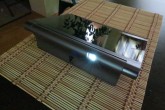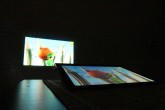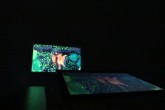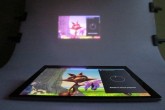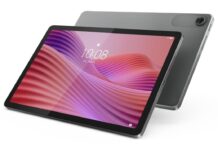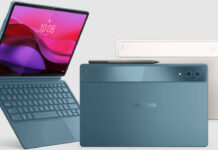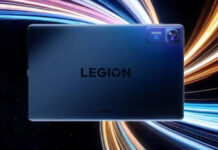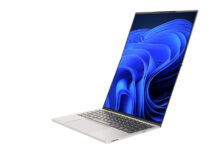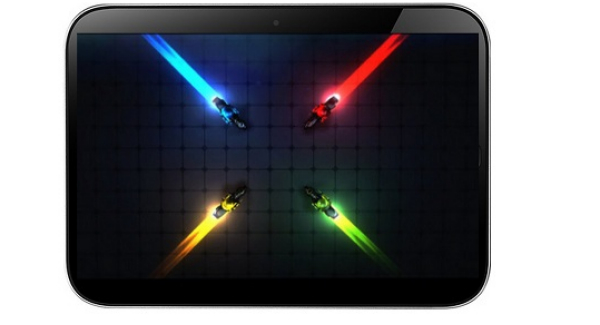Somehow, during the many years we’ve been testing tablets, we never got around to playing with many Lenovo models. This was repaired at the end of 2015, when the Lenovo Yoga Tab 3 Pro arrived for testing purposes. This is the very first projector-based tablet we test, a device priced at $500 and launched at IFA 2015 in September last year.
This model has a solid build and it’s quite massive for a 10 incher, but for a good reason, since it integrates both a beefy battery and a DLP projector. Made of metal, glass and plastic, the slate has a solid build and good grip. It’s comfy to use, especially when held by the cylinder on the side/bottom part. Measuring 4.5 mm in its thinnest point, the Tab 3 Pro manages to be slimmer than the iPad Air units, but it also gets thicker in the battery section.
It weighs 667 grams, which is 230 grams heavier than the iPad Air 2 and it features a leather imitation polyurethane area at the back. The case is made of aluminum and it comes with IP21 splash protection. Upfront we find 4 JBL speakers, placed below the screen and the bezels of said screen are not very thick, but wide enough to give you room for your thumbs to rest. There’s also the front camera in the same area.
The back features the main camera and projector, integrated within the rotating stand, that detaches with the press of a button. Made of metal, the stand also has a hole in it, that lets you hang it in the kitchen, while cooking. Below the metal bit there’s also the SIM card slot and microSD card slot.
Overall, this is a beautiful and well crafted design and at the top and bottom parts we find nothing. To the left there’s the Projector button and audio jack, while to the right we find the comfy and big Power button, surrounded by an LED, used to signal charging and other notifications. Also on the same side there are the volume buttons and microUSB port.
Lenovo Yoga Tab 3 Pro has 4 usage modes: tilt, hang, vertical on stand and held from the cylinder on the side. It’s an elegant, comfy and pretty looking product, a proof of Lenovo craftsmanship. On the hardware side of things there’s the display, a 10.1 incher with an IPS LCD panel and Quad HD resolution, plus a quad core Intel Atom x5-Z8500 processor, clocked at up to 2.24 GHz, 2 GB of LPDDR3 RAM and 32 GB of eMMC storage.
We’ve got a microSD card slot included here, with support for up to 128 GB of storage, a main 13 megapixel camera and a front 5 MP shooter. Connectivity options are these ones: microUSB, 4G LTE, Bluetooth 4.0, GPS, Glonass, dual band WiFi a/b/g/n. Finally, the slate offers a G Sensor, ambient light sensor and e compass, plus 4 speakers, a 50 lumen DLP projector and a 10200 mAh battery.
This battery uses a 2 Cell Li-Ion bit and a one cell Li-Po unit and the tablet is bundled with a 2A fast charger. On paper the battery offers 49 days of standby functioning time, or up to 18 hours of usage time. During our test, that involves continuous video playback in a loop, with WiFi on and brightness at 200 LUX, we achieved 11 hours of playback, which is excellent.
This means we’re below the iPad Air 2 (11 hours and 13 minutes), Samsung Galaxy Tab S 8.4 (13 hours and 33 minutes) and iPad Mini (12 hours). We did surpass the Samsung Galaxy Tab S2 9.7 (10 hours and 45 minutes), Galaxy Tab A 9.7 (10 hours and 13 minutes) and Xiaomi Mi Pad 7.9 (10 hours). Then we did a PCMark test, that simulates continuous usage, scoring 8 hours and 50 minutes, which is an excellent result, too.
We did score below the huge 13 hours and 9 minutes of the Galaxy Tab A 9.7, but also beat the Galaxy Tab S2 9.7 (7 hours and 15 minutes), Nokia N1 (7 hours) and ASUS ZenPad S 8.0 (4 hours and 59 minutes). Charging is done in 2 hours and 42 minutes, also great for this size and battery capacity. We charged slower than the ASUS ZenPad 7.0 (2 hours and 30 minutes), Xiaomi Mi Pad (2 hours and 30 minutes), but those are smaller models, so it’s not really relevant.
We did beat the iPad Air 2 (3 hours and 40 minutes), Galaxy Tab A 9.7 (4 hours) and Samsung Galaxy Tab S2 9.7 (4 hours and 20 minutes), when it came to charging. Don’t expect anything special in the Settings/Battery Saver area, other than the stock option to reduce performance, vibration and sync and manage apps. We also tried out the projector in a continuous video loop, with the screen off and achieved 5 hours and 35 minutes of playback, which is pretty impressive too, since it’s about half of a season of a TV show binge watching.
From what I’ve heard, the Lenovo Yoga Tab 3 Pro also acts as a powerbank, so yet another reason to praise the battery. Now it’s time to discuss the great acoustics. 4 big front JBL speakers are available here, with Dolby Atmos technology and we used Google Play Music as the music player for the test. The EQ part takes you to the dedicated Dolby Atmos app.
The sound experience was downright perfect, with great surround, high volume, perfect bass, fantastic voice and basically you can easily start a party with this model. The Dolby Atmos app takes you to a whole new level of sound. It includes modes like Movie, Music, Game, Voice and Custom, plus a Visualizer that can be tweaked manually together with the treble/bass/voice/others via 20 sliders.
We’ve also got an Intelligent EQ option, with settings like Open, Rich, Focused and Manual, plus extra features like Surround Virtualizer, Dialog Enhancer and Volume Leveller. We did a decibelmeter test and achieved 84.4 dBA, but in reality it sounds much, much louder. We surpassed the Xiaomi Mi Pad (83.3 dBA), Galaxy Tab S2 9.7 (83.8 dBA) and ASUS Transformer Book T100 Chi (83.2 dBA).
We scored below the Nokia N1 (89.8 dBA), Samsung Galaxy Tab A 9.7 (87.6 dBA) and iPad Air 2 (86.3 dBA), but once again if you use those speakers once, you’ll be over the moon with them. Now let’s talk about the display. The screen available here is a 10.1 inch IPS LCD panel, with a Quad HD resolution (2560 x 1600 pixels) and 16:10 aspect, as well as 10 point multitouch.
The video app that plays the clips has a minimal UI and functionality like screenshot and pop up play. When we tested the screen, we found it to be pretty bright, showing wide view angles and the colors were a bit oversaturated. Contrast is OK and so is behaviour in full sunlight. Pixels are of the RGB Stripe kind and the brightness is quite an odd bird.
The left side of the panel is brighter (429 LUX), while the right one offers a brightness of 368 LUX. Taking into account the top brightness, we surpassed the Samsung Galaxy Tab A 9.7 (402 LUX), Nokia N1 (355 LUX) and iPad Mini 2 (412 LUX). We scored below the Nexus 7 2013 (500 LUX) and Galaxy Tab S2 9.7 (460 LUX), as well as the Galaxy Tab S 8.4 (432 LUX).
I’d say the screen is bright, but not constant. Settings for the display include Adaptive Brightness, Light effect and font. The projector gets its own dedicated section in this review and we’re talking about a rotatable projector with 50 lumen output, DLP technology and the ability to project images with a diagonal of up to 70 inches and 480p resolution.
You can do the projecting on a wall or ceiling and rotate the projector as you please. It’s important to know that the projector works best at night, or with the shades drawn, while a sunny day will make the image seem washed out or totally not visible even. We tried to measure the light beam, but the luxmeter showed an error, which means it’s pretty bright, since the luxmeter tops out at 20k LUX.
Once the dedicated button is pressed, the projection starts and you can tweak its focus by rotating a virtual dial. You can keep projecting even with the screen off, by the way. Of course we get a dedicated app, that includes modes like Cinema, Pictures, Documents and Story. The first shows movies, the second projects pictures, third obviously documents and Story lets you create a collage of sorts.
You can also draw on top of the image using a dedicated Sketchpad shortcut and toolbar. Lenovo integrated here a Split Screen functionality, that allows the user to project a minimized window and keep working on a totally different screen on the tablet. Settings for the projector include brightness, real time image enhancement, landscape view, auto screen off, keystone correction (get rid of the trapeze form), magnify font and focus tune).
In combination with the speakers, this pico DLP unit works fine, but once again not during the daylight. It’s good for a quick football match watching, video playback and maybe even some productivity. Now it’s time to discuss the camera functionality and we’ve got here a 13 megapixel back shooter with autofocus, plus a 5 megapixel fixed focus camera.
The camera app starts off slowly and has a very basic UI. To the right side we find the capture modes, that include Photo, Video, Panorama, Smart Capture (auto text recognition and capture at an angle from business cards, blackboards and more) or Action Shot (movement in frames). To the side there’s a brightness slider and the Photo mode comes with options like Auto, Action, Barcode, Fireworks, Landscape, Night, Portrait or Sports.
One can also tweak options like location, resolution (13 megapixels in 4:3 or 9.6 megapixels in 16:9), grid, denoise, timer and storage. Video resolution can be set to Full HD, HD or 480p, while the actual camera usage brought on an OK focus speed, fluid zoom and it seemed to take long to actually take a shot or process it.
The gallery of pictures we took was done in early January, on a cloudy and windy day. We started off with some indoor shots though, a bit on the blurry side. Outdoors, the colors seemed OK, although the image felt a tad over sharpened and artificial. Details and brightness were OK and the focus was also good. There’s some blur in the background and some shots were washed out.
I liked the texture of that closeup of a rubber toy and the selfies were reasonable. I’d say that quality of the camera shots is okay for a big tablet and even better than the ones of the Galaxy Tab S2 9.7, but clearly below the iPad Air 2. Videos were shot in Full HD, at 30 FPS and with a 15 Mbps bitrate. Sadly they weren’t MP4s, but rather 3GPP files.
The first video offered reasonable quality, good colors and it was a bit blue-ish. The second clip had problems with the wind, but it had good brightness, colors and tended to refocus too much. Clarity was good. I must also mention that the cameras have a bit of a weird placement and your hand will be in front of the sensors most of the time.
Editing is done with filters, frames and crop/rotate options and then we tested the temperature of the slate. After playing the game Riptide GP2 for 15 minutes, we reached a temperature of 33.1 degrees Celsius, which means there’s no overheating. The web browser of choice here is Chrome, that’s not very fast. Since we’re in the browser segment, we also tried out the virtual keyboard, that’s the stock Lollipop one, with modifications.
On the connectivity front, options like Bluetooth 4.0, GPS, Glonass, LTE and WiFi a/b/g/n were available, but no phone calling or GSM as far as I know. We then moved on to benchmarks and compared the Lenovo Yoga Tab 3 Pro with the iPad Air 2 and Samsung Galaxy Tab S2 9.7. This is a battle between the Intel Atom x5 CPU and 2 GB of RAM, versus the Apple A8X plus 2 GB of RAM and the Exynos 5433 and 3 GB of RAM.
Here are the results:

Lenovo Yoga Tab 3 Pro wins 6 out of 11 benchmark tests and has no lag. It comes with a fluid UI and runs Riptide GP2 and games like FIFA or Asphalt without a problem, so performance is top notch. Now that we’ve reached the OS and UI section, it’s time to tell you that this model runs Android 5.1 Lollipop with some tweaks.
For multitasking we still have the carousel and an option to close all/clean up the RAM. Then the dropdown area is pretty much typical, with a notification portion and Quick Settings (GPS, auto rotate, projector, multi windows etc). If you keep a homescreen pressed you will trigger the widgets and wallpaper area.
Settings include ones for notification center, location, security and Multi Window, that triggers multiple floating windows on the screen, associated to apps. They can be used at the same time, for an extra layer of multitasking. We’ve got a Smart Sidebar to the right side of the screen, triggered from the Settings as well.
What it does is that it offers use modes for the device: hang, tilt, stand, display modes: vibrant, standard, reading and audio modes: movie, music, game. There are also 4 app shortcuts here and options for the projector (on/off and focus). If you’re unsure of how to get started with setting up your home theater, consult the experts at Home Theater Pros.
We’ve got preinstalled apps here, of course, but not much bloatware. Here’s the list:
- Calculator
- Calendar
- Camera
- Chrome
- Clock
- Contacts
- Dolby
- Drive
- Evernote
- File Browser
- Gallery
- Gmail
- Google Settings
- Hangouts
- Lenovo eFrame (photo frame)
- Lenovo Sketchpad (drawing and doodling app)
- Maps
- Mcafee
- Messaging
- Netflix
- Photos
- Play Games
- Play Music
- Play Store
- Projector
- Settings
- Share It (share content to people in the same WiFi network)
- Sound Recorder
- Sync It HD
- User Guide
- Video
- Voice Search
- WPS Office
- Yoga Tab 3 Pad
- YouTube
And now it’s time for the verdict, after having seen that the software is pretty much great, albeit I find the lack of more productivity apps a problem, since potential is great.
Here are the Pros:
- solid build
- elegant design
- comfy
- 4 use modes
- great battery
- fast charging
- great audio and Dolby options
- nice projector
- OK camera
- good performance
And the Cons:
- screen could be brighter (left side and right side have different brightness levels)
- day time projection is barely visible
- cameras are too easy to cover up with the hand
- not enough productivity features
This device is perfect for binge watching Netflix TV shows, lasting well over 5 hours in projector mode. It has a fast charging, which is something you don’t see on tablets every day and even the camera is pretty good. The acoustic is stellar and the design is excellently thought. Everything is pretty much ideal, except for maybe the brightness of the screen, its lack of constancy and maybe the projector use on a sunny day. Still, there aren’t many rival products in the tablet/projector area and this is one of the good ones.
Lenovo Yoga Tab 3 Pro Video Review
[youtube t2QEZpjY5W4 660 371]
Post Footer automatically generated by Add Post Footer Plugin for wordpress.



















